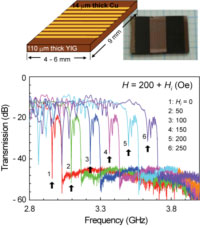Research highlights
Ultra high sensitivity magnetic field sensors: The attraction of magnonic crystals
Highly sensitivity devices for the measurement of weak magnetic fields are important in medicine for applications such as monitoring heart and brain activities. Furthermore, mapping the distributions and magnitudes of weak magnetic fields can provide a deeper insight into neuroscience and brain-machine interfaces.
Here, Mitsuteru Inoue and colleagues at Toyohashi University of Technology demonstrate that magnonic crystals—artificial magnetic crystal structures for controlling the propagation of magnetostatic waves—exhibit properties enabling the fabrication of extremely sensitive magnetic field sensors operable at room temperature.
Magnonic crystals support the propagation of magnetostatic waves through the crystal spin system or suppress the propagation of waves due to the periodicity of the crystal structure. In this research the Toyohashi Tech researchers fabricated magnonic crystals by the direct formation of one-dimensional arrays of metal strips on top of yttrium iron garnet, which serves as the propagation medium.
The metal stripes induced an attenuation band in the frequency spectra of the magnonic crystal, and the propagation of waves with the corresponding frequencies was strictly prohibited.
The frequency of the attenuation band was very sensitive to an external magnetic field applied to the crystal, where a 1 Oe change in the field resulted in a 2.6 MHz shift in the band gap. The maximum detection sensitivity of the magnonic crystals was more than 10 times greater that of a giant magneto-impedance element.
The next challenge for the researchers is to demonstrate the measurement of magnetic fields in three dimensions, which is possible using two-dimensional magnonic crystals.
- Reference:
- Mitsuteru Inoue, Alexander Baryshev, Hiroyuki Takagi, Pang Boey Lim, Kohei Hatafuku, Josho Noda, and Kenji Togo
- Investigating the use of magnonic crystals as extremely sensitive magnetic field sensors at room temperature
- Applied Physics Letters 98, 132511 (2011)
- DOI: 10.1063/1.3567940
- Department of Electrical and Electronic Engineering, Toyohashi University of Technology, Japan
- Department website: Inoue Lab:
http://www.maglab.eee.tut.ac.jp/eng-index.html

Mitsuteru Inoue

Enlarge Image
Figure: (a) Schematic illustration (left) and photograph (right) of the one-dimensional magnonic crystal. (b) The magnonic band gap (shown by arrows) shifts when an external field is applied in addition to a bias field of H = 200 Oe.


